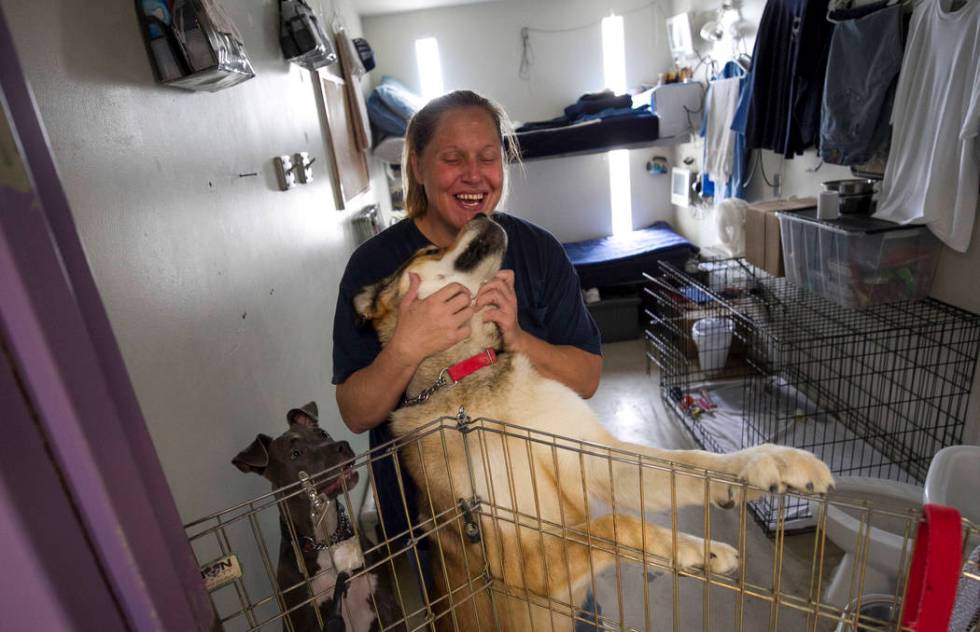Inmates practice training, companionship with Pups on Parole

When Honey, a spotted Catahoula Cur, took her first steps onto a treadmill Tuesday, she was behind bars.
“Good girl,” said Melonie Sheppard, holding Honey’s red leash with bones on it. “Not bad for her first time.”
While the barbed wire outside and the 10-foot-square cells inside Florence McClure Women’s Correctional Center are meant to keep Sheppard, an inmate, in, Honey is there, waiting to be trained, so she can get out.
She is one of 24 dogs being trained by inmates through Pups on Parole, a program presented by the prison and the Heaven Can Wait animal shelter that aims to prepare abandoned and troubled dogs for adoption.
Pups on Parole teaches prisoners animal training and care. Dogs spend a couple of months to a year at the prison. They are walked twice a day, fed and played with. Program coordinators say the program’s inmates are better prepared for life outside of prison and less likely to return.
Thirty-six women live in the pup pod, a cell block called General Population 5N. Thirty have dogs. Inmates have decorated the block’s purple doors with names of dogs that lived there. Dakota. Corky. Spike.
Behind the doors are the inmates’ small cells, equipped with bunk beds. In Sheppard’s room, a fence is set up for her new dog, Onyx, who arrived Tuesday. She said the year-old bull mastiff probably weighs about 120 pounds; he takes up more than half the room.
“That’s the pony,” said Dwight Neven, the prison’s warden. “Holy smokes.”
‘A lot of love’
Some dogs who come to the prison were about to be euthanized or came from homes where they were no longer wanted. Onyx’s owners surrendered him to the shelter because they couldn’t take care of him anymore.
Now, Sheppard, 44, has the challenge of training him.
“He’s gonna come with us and get a lot of love,” she said.
Pups on Parole participation won’t give inmates time off a sentence, associate warden Gabriela Garcia said. The reward is the satisfaction of doing something intrinsically good.
“They learn that it’s not just about you. It’s about the dog,” she said. “In their previous lifestyle, it’s all about you. That’s why they ended up in prison.”
To participate in Pups on Parole, inmates must have a high school diploma or GED certificate, or have passed mental health screenings. They have to be free of discipline violations for six months, have a full-time prison job or be furthering their educations.
The 10-month program makes the inmates certified trainers.
Inspiration from TV
Rachel Vosko first thought to align her Heaven Can Wait shelter with inmates after watching a television show about therapy dogs. She also owns five local Bogart’s Bone Appetit dog stores, which sell food, grooming and bakery items. She sometimes hires the inmates or sets them up with jobs on the outside.
Sheppard has been in Pups on Parole for five years and in prison for 15. She went to prison at 28 after setting up a drug deal that went bad. Her life sentence was recently overturned, and she’ll get out in the next few years. She plans to keep working with dogs.
“I need a purpose,” she said. “I know that I’m in prison, but I still have meaning.”
Erica Womack, 25, patted Honey on the back. She’s had her for three months and is working to stop her from chewing idly.
“She loves my toilet paper,” she said. “She loves to make it snow.”
When Womack gets out of prison in January, she said, she wants to keep training dogs.
“It’s given me all the skills I’m going to need when I get out.”
^
Contact Briana Erickson at berickson@reviewjournal.com or 702-387-5244. Follow @brianarerick on Twitter.